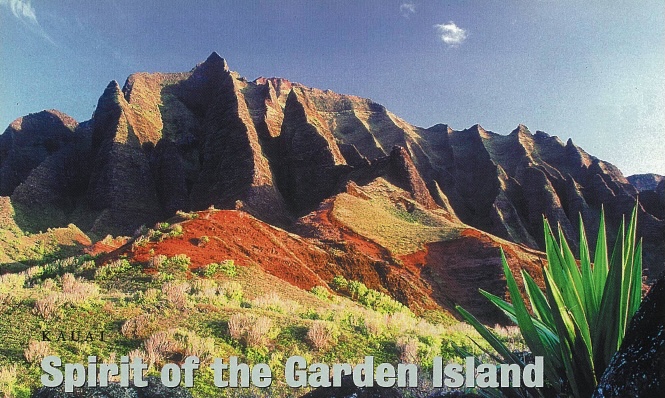Six million or more years ago, at the most isolated spot in the mid-Pacific ocean, the volcanic island now known as Kauai formed as the Pacific tectonic plate slowly moved over a “hot spot” in the Earth’s crust. Today that same breach in the Earth’s crust (now over 300 miles from Kauai) continues to feed the active volcanoes on the Big Island of Hawaii, the youngest island in the chain.
Kauai is now cool, geologically speaking and otherwise. The oldest of the Hawaiian islands, its volcanoes are inert, and it is now at the mercy of pounding blue ocean waves, the most rainfall of any place on the planet and calm but constant tradewinds. The result of this relentless erosion is extraordinarily evident on Kauai, where the scars of these environmental battles are carved into its face. Lush landscaped valleys, razorback ridges, long strands of beach–all that we so love about Kauai is the result of nature’s siege.
Kauai is 553 square miles, and 50 of its 113 miles of shoreline are composed of sand beaches–the highest proportion by far of the Hawaiian islands. Kauai’s interior is mountainous, with deeply eroded valleys and large plains around most of the coastal areas. Located in the center of the island is Mount Waialeale, meaning “rippling waters.” The ancient Hawaiians recognized the importance of this spot and built a temple on the summit. In this temple, God (Kane) was represented by a simple upright stone–similar to the Siva Lingam of Hindus (and the crystal destined for the Island Temple).
Kauai harbors an astounding variety of environments. Mt. Waialeale is the rainiest spot on the planet, with an average of 440 inches of rain per year. Just a few miles to the west, rain is rare, creating dry, almost arid conditions. The north shore is as lush as any place on the planet, and the south shore is a sunny playground. The island’s first polynesian inhabitants surely must have felt blessed at the discovery of this diversity.
Many of the ancient beliefs and practices of these intrepid adventurers bear striking resemblances to Hinduism, such as the belief in one supreme God, Kane, along with other significant Deities, and working closely with the spirits of nature. These corollaries and recent linguistic and DNA revelations have led some authorities to speculate that the ancestors of the Hawaiian settlers may have begun their journey in India.
Kauai today is an ethnic mix that is as diverse as any you can find. Here, there are no majorities. We are all Kauaians, and Kauaians are the friendliest people in America, a distinction given by the magazine of choice for world travelers, Condé Nast. A trip to Kauai is like a journey back in time, when smiles came easy and politeness prevailed. This spirit of loving brotherhood is ALOHA –where ‘A’ means akahai, kindness; ‘L,’ lokahi, unity; ‘O,’ olu’olu, agreeableness; ‘H,’ ha’aha’a, humility and ‘A,’ ahonui, patience –this is the meaning of Kauai’s “aloha spirit.”
Visitors to Kauai immediately sense the unique spiritual vibration of the island. In addition, Kauai is also recognized as an oasis of healing. Complementing the natural spirit-power of the island, a wide variety of holistic health practitioners are established here. These include the ancient Indian arts of ayurveda, yoga and astrology.
When Hollywood wants to convey beauty, lushness and the exotic, Kauai has long been the island of choice. Blockbuster films such as South Pacific, King Kong, Raiders of the Lost Ark, Honeymoon in Vegas, George of the Jungle, Jurassic Park, 6 Days/7 Nights and more have featured Kauai landscapes. Filmmakers and actors have cited the pleasantry of the people and the easy-going calm of Kauai as what compels them to return. For despite all its attraction, Kauai remains an uncrowded, uncommercialized refuge.
Plenty of places in the world offer sun and sea, but no other place offers the incomparable beauty, lushness, serenity and soulfulness of Kauai. Come, discover your Kauai!
EXCERPTED WITH PERMISSION FROM THE ULTIMATE KAUAI GUIDEBOOK, WIZARD PUBLICATIONS, WWW.WIZARDPUB.COM


